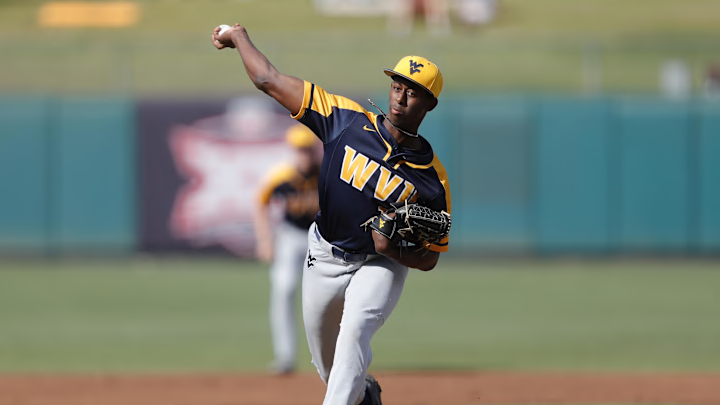One of the many pitchers the Pittsburgh Pirates selected in the 2023 MLB Draft was right-hander Carlson Reed. Reed only pitched as a reliever throughout his final year at West Virginia University before being taken in the fourth round, but the Pirates have pivoted and used Reed as a starting pitcher in 2024. So far, it’s worked out extremely well.
Reed has pitched 55 innings with a 2.29 ERA, 3.38 FIP, and 1.24 WHIP. Reed has a 29.6% strikeout rate, has only allowed two home runs all year, and has a ground ball rate of 54.1%. Reed has been able to keep batters off balance all season. He’s induced a swing-and-miss rate of 31.3%. The average whiff rate at A-Ball this year is 30.2%. When batters do make contact off of Reed, it’s typically been weak contact, with an 84.5 MPH exit velo, significantly lower than the A-Ball average of 86.8 MPH. His opponent barrel rate is a microscopic 1.8%.
The one downside about his season thus far is his 13.5% walk rate. Reed struggled with command last year at WVU, and it’s been the worst part of his 2024 season so far. He has looked slightly better with his control over his last six starts with an 11.5% BB%, though his command can still be off.
All of Reed’s numbers are good, but is his stuff good enough to back it up? It's worth diving deeper into each of his offerings.
What does Pittsburgh Pirates pitching prospect Carlson Reed's arsenal look like?
Sinker
Reed’s primary pitch this season has been his sinker. Reed sits around 91-93 MPH and has topped out at 95-96 MPH. The pitch averages just under 1900 RPM at 1894. While Reed hasn’t induced many swings and misses with this offering, with a 14.2% whiff rate, it has displayed above-average movement. 22.6 inches of downward vertical movement is about average, and 13.6 inches of glove-side horizontal break puts him just under the MLB average of 15 inches. Hayden Wesneski of the Cubs has a similar sinker, based on velo and movement.
Four-Seam Fastball
Along with a two-seam sinker, Reed also tosses a four-seam fastball. He throws this offering slightly harder, sitting at 93.6 MPH and topping out around 96-97 MPH. Carlson has induced a higher whiff rate with this offering at 22.6%. In terms of movement, the pitch has decent ride through the zone with only 15.6 inches of vertical drop, but lacks significant horizontal movement at just eight inches (MLB average is 7.7 inches). Michael Soroka’s four-seam fastball has similar attributes to Reed’s.
Slider
Carlson’s primary breaking pitch is a slider. His slider sits in the low-80s and tops out around 86 MPH. Reed averages 2645 RPM with his slider. Batters haven’t been able to touch the pitch, with a 60% whiff rate. Even when they have been able to make contact, he’s kept them to a meager 80.9 MPH exit velocity. Reed’s slider has 37 inches of vertical drop, which is about an inch better than the MLB average, but the pitch has a ton of horizontal break at 11.8 inches. Andrew Nardi of the Miami Marlins has similar slider movement and velo. There's a reason we've targeted Nardi in recent proposed trade packages.
Changeup
Reed’s changeup has been a great offspeed pitch. He throws this offering at 83.4 MPH, topping out at 90 MPH, and with only 1611 RPM. He’s been able to induce even more swings and misses on the change than on his slider, with a 62.2% whiff rate, and it’s been even better at limiting hard contact, with a 77.8 MPH exit velocity. Reed’s changeup has 31.4 inches of vertical movement and 12.8 inches of horizontal arm-side movement. Former Pirate and current LA Angel Tyler Anderson’s changeup has nearly identical movement, though Reed throws harder than the lefty.
One thing that makes Reed’s pitches play up is his release point. Reed stands at 6’4”, 200 pounds. He has long arms, and that helps him release the ball nearly seven feet out in front of the rubber. This adds a level of deception to his offerings, making them look faster than they are. Reed’s four-seam fastball might only average 93.4 MPH, but looks more like 94.3 MPH out of the hand. The same goes for his sinker, which averages 92.3 MPH on the gun, but looks more like 93.2 MPH the way Reed throws the ball.
Reed has been surprisingly good as a starting pitcher. While it’s still not out of the question he ends up as a reliever, his stuff has played well at A-Ball. He’s been one of the best-performing pitchers in the Pirates’ system, and it will be interesting to see if he can continue to develop as a starter. He’s only 21, and still has time to up his velocity. If he can get to 94-95 MPH in longer outings, it could determine if he ends up as a starter or reliever.
